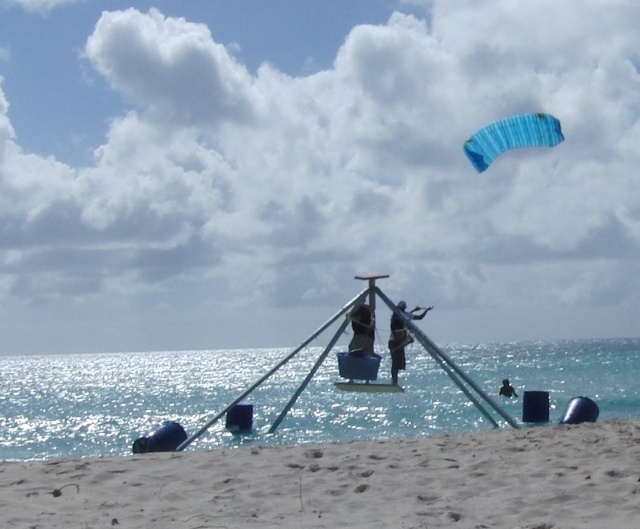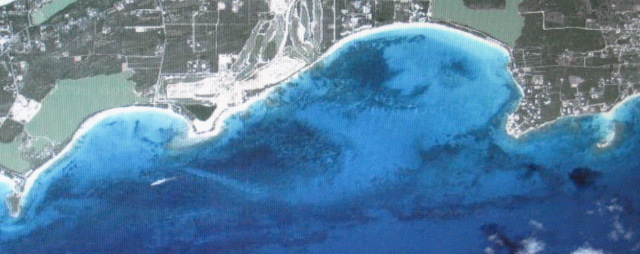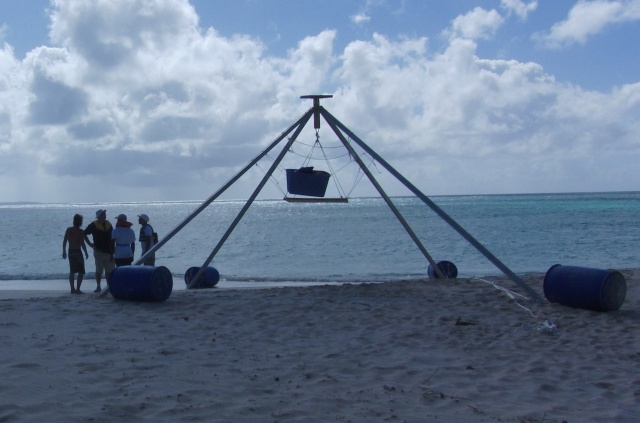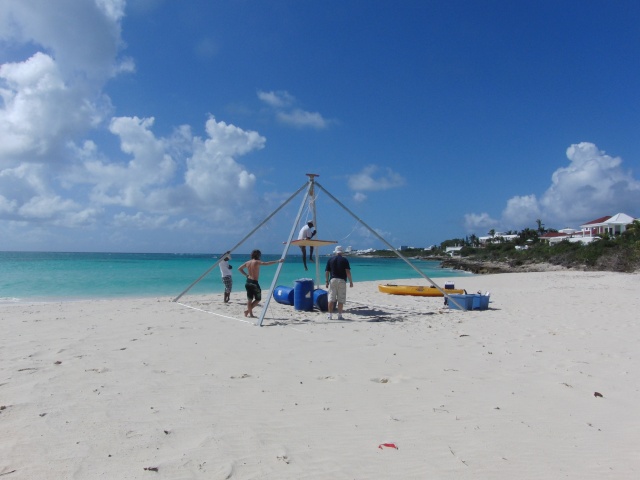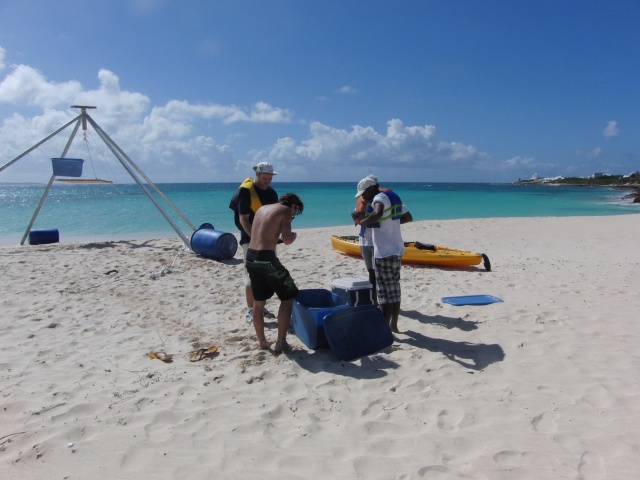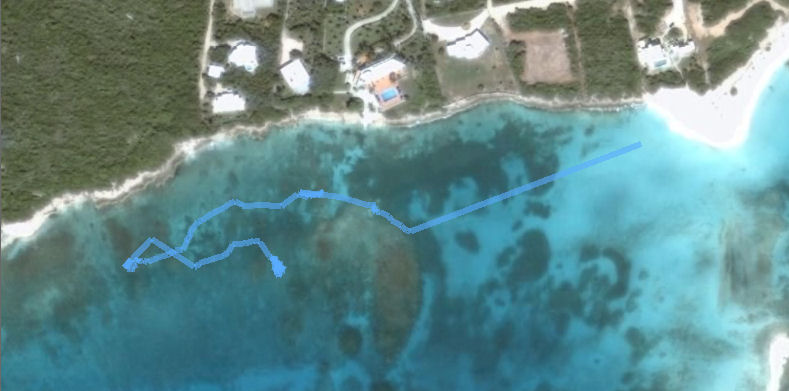Difference between revisions of "User:Vincecate/WaterWalker2"
(→Weights) |
|||
| (191 intermediate revisions by the same user not shown) | |||
| Line 1: | Line 1: | ||
| − | + | Built a 1:4 or 1:5 scale model/prototype like the [[User:Vincecate/WaterWalker|WaterWalker model]] that is big enough for 3 people to take a [http://online.offshore.com.ai/balseros/ kite powered ride along the South side of Anguilla]. | |
| − | The legs | + | The legs were 20 feet long. I have done [[User:Vincecate/Models|several seastead models]] but this was the first large enough to play on. |
| − | [[Image: | + | [[Image:WaterWalker2WithKite.JPG|640px]] |
| − | |||
| − | |||
| − | + | ||
| + | ==Costs== | ||
| + | |||
| + | * Main Rope - $108.59 - [http://www.amazon.com/gp/product/B0009WG684 150 feet of 3/4 inch nylon rope] | ||
| + | * Barrels - $80 - 4 from a West Indies Concrete in Anguilla at $20 each | ||
| + | * Steel Beams - $212 - 4 steel box-beams at $53 each (called "3-inch square tubing" at the store) | ||
| + | * Hardware - $120 - hinges, nuts, bolts, L-brackets, washers, small rope | ||
| + | * Wood beam - ~$20 | ||
| + | * Plywood - $35 | ||
| + | |||
| + | * Total $575.59 | ||
| + | |||
| + | The barrels are a great deal. The rope price does not include shipping and duty. The other prices are tropical island prices which include shipping and duty - US prices should be less for these things. | ||
==Weights== | ==Weights== | ||
| Line 15: | Line 25: | ||
* 3" square tube 20 feet long - 48 lbs | * 3" square tube 20 feet long - 48 lbs | ||
* 4x4 at 16 feet long - 60 lbs | * 4x4 at 16 feet long - 60 lbs | ||
| + | * 4x4 at 20 feet long - 75 lbs | ||
==Flotation== | ==Flotation== | ||
| − | + | The barrels are 54 gallons which is 432 lbs in fresh water and a bit more in salt water. The plastic underwater should float so only about half of the 20 lbs of the barrel really counts, or 10 lbs. The ropes holding the base in shape will probably be underwater and should nearly float. | |
| + | |||
| + | * Flotation 1783 lbs (from 4 barrels in salt water) | ||
| + | * Using half each 891 lbs | ||
| + | * Weight of beams 192 lbs (4 metal beams) | ||
| + | * Weight of half of barrels out of water - 40 lbs | ||
| + | * Weight of misc 100 lbs (short central beam, platform, and various hardware) | ||
| + | * Available for people and other cargo 559 lbs | ||
| + | |||
| + | Might fill lower part of steel tubes with foam so they float. This would add a bit extra flotation. | ||
| + | |||
| + | If we had an aluminum box beam that was thick enough to weld to we could close off the end and make something to attach to at the same time. A 6 inch square aluminum box beam would be great. Aluminum is a better choice for a production model but it costs much more so I am not using it for this prototype. | ||
| + | |||
| + | ==Design Decisions== | ||
| + | |||
| + | There have been several design decisions that I puzzled over. | ||
| + | |||
| + | * Going from 3 legs to 4. I did this because it gives me a wider base and lets me use 4 of the cheap barrels I have available. With this I am sure I can carry 2 people and maybe more. Makes structure a bit more complex. | ||
| + | * How to join the legs together at the top. With 4 legs the 4 hinge method on a central column seems good. But it is a potential weak link. | ||
| + | * With 4 legs it makes sense to have diagonal ropes between the legs but I think this is not really needed. Without the diagonals opposite sides can move in or out while other pair does opposite. Should be limited range though as weight is transfered to legs coming together. Might reduce passenger motion. A WaterWalker with moving legs seems fun to try. Makes tying the platform not so easy, but might be OK without ties. | ||
| + | * Ropes out of the water or at ends of legs? If the ropes are out of the water there is less drag for the structure moving through the water; however, the stress on the leg is more. If the ropes are in the water they can help to attract fish. Can also use the same attachment point used to tie barrels. Expect to tie at ends of legs. | ||
| + | * Height/width ratio. If the structure is wider it is more stable, but there is more stress on the beams and ropes. With ropes at ends there is less stress on beams and I can make structure wider before breaking anything. I also think there is less risk of trouble from leaving off the diagonal ropes if the structure is very wide. | ||
| + | * How to make platform for people. Don't want it to be too heavy but people need to be able to hang out for the whole trip. Decided on a small seat at the very top and a 4' by 4' platform about 4 feet down from joint. Can lean on the legs while standing. Attaching both with L brackets. | ||
| + | * How to attach the barrels | ||
| + | ** Strap barrels along end of the leg - no movement or danger of hitting leg but bigger waterline area | ||
| + | ** Tie them so they float horizontally with tail fin so line up in direction of movement - could reduce drag when moving through the water. Complicated with what I have. | ||
| + | ** Tie them so they float in normal barrel orientation (vertical) - minimizes waterline area - some danger of barrel hitting leg. With ropes and legs in the water heave should not be too much of a problem. Choice I made. | ||
| + | |||
| + | |||
| + | |||
| + | ==Planned Route for Maiden Voyage== | ||
| + | |||
| + | [[Image:WaterWalker2map.JPG]] | ||
| + | |||
| + | My current plan is to do a [http://maps.google.com/?ie=UTF8&t=h&ll=18.164773,-63.132763&spn=0.074377,0.11055&z=13 2 to 4 mile route] that is mostly downwind and never far from land. Will go [http://maps.google.com/?ie=UTF8&t=h&ll=18.169885,-63.096591&spn=0.002329,0.003455&z=18 into the water at one beach] and then get [http://maps.google.com/?ie=UTF8&t=h&ll=18.170166,-63.132559&spn=0.004659,0.006909&z=17 out of the water at another beach 2.5 miles over], or maybe [http://maps.google.com/?ie=UTF8&t=h&ll=18.165257,-63.14074&spn=0.002329,0.003455&z=18 the West end of that beach for a 3 mile trip], or if things are going really well [http://maps.google.com/?ie=UTF8&t=h&ll=18.164804,-63.157461&spn=0.004659,0.006909&z=17 a beach even further for about 4 miles]. The wind is normally from the East and we will do this on a day when that is so. Will have a person in Hobie Outback nearby and may change people during trip. The kayak may pull the model a bit south at the start if the kite has any trouble pulling the model south enough to clear land 1/2 mile from start. | ||
| + | |||
| + | If we can average 1/2 MPH then it would be about 5 hours to make the 2.5 miles. At 1:5 scale this is simulating a 12.5 mile trip at 1.12 MPH. | ||
| + | |||
| + | ==Things to bring on experimental voyage== | ||
| + | |||
| + | * Life jackets for everyone (4)- 3 people on board model 1 in kayak | ||
| + | * Sun screen | ||
| + | * Water/drinks/cooler/food | ||
| + | * Sea Anchor - test how much it slows model down | ||
| + | * Anchor | ||
| + | * Kite/pulley/attachment-rope, maybe backup kite | ||
| + | * Cell phones in dry bags (phones charged and with money) | ||
| + | * waterproof camera in kayak | ||
| + | * cheap camera in dry bag on seastead | ||
| + | * expensive camera on land with tripod - with extra batteries | ||
| + | * GPS - map, to record route, see how much off downwind we can go, how fast | ||
| + | * Paper chart, print of Google maps in dry bag | ||
| + | * Kayak/paddles/pedals | ||
| + | * Extra rope | ||
| + | * Log-book and pen | ||
| + | * Maybe plan to tie sea-anchor between legs to make shade on platform | ||
| + | * Hand radios in kayak, seastead, land (3 total) | ||
| + | |||
| + | ==Maiden Voyage Results== | ||
| + | |||
| + | [[Image:WaterWalker2launchprep.JPG|640px]] | ||
| + | |||
| + | Miguel and Vacquelin did most of the construction for WaterWalker2. They were home from college for Christmas and heading back on Jan 8th. So the last day to launch was Jan 7th and we were in a hurry to do so. Vacquelin is the one who has done any nice sketchup drawing that I have posted. | ||
| + | |||
| + | We had 3 people on the Seastead, Vince, Miguel, Veselin. Vacquelin was in the Kayak, and Bob Hettinga was the land based photographer and responsible for getting any needed rescue boats. | ||
| + | |||
| + | We had the seastead folded up with the main rope still on when we drove it to the beach. It is a bit difficult to raise and lower when closed like an umbrella. It is easier to lower the center all the way down, but to do this you have to take off the main rope around the ends of the legs. It is also easier to load on a car one leg at a time than altogether and we only have to remove 6 bolts to take off the 4 legs. | ||
| + | |||
| + | [[Image:WaterWalker2OnBeach1.JPG|640px]] | ||
| + | |||
| + | [[Image:WaterWalker2OnBeach2.JPG|640px]] | ||
| + | |||
| + | <youtube v="AdEjM69Htj8" /> | ||
| + | |||
| + | ==GPS / Speed / Angle == | ||
| + | |||
| + | [[Image:WaterWalker2GPSPlot2.jpg]] | ||
| + | |||
| + | In this plot of the [http://docs.google.com/Doc?id=dffxg4th_56z4pzwqfg GPS data] we started at the upper right dot and head left and down some under kite power. Then we are working our way past rocks curving up, left, and then down. Then a dingy pulls us down and back to the right where we anchor. | ||
| + | |||
| + | The data says that the first line (kite portion) was 654 feet at a heading of 249 degrees. This is probably about right and means we did like 21 degrees South of West when the wind was going West. The kite was probably pulling us more like 45 degrees south of West. Our track was a compromise of the wind push and the kite pull. The GPS says we did this 654 feet in 12 seconds, but really it was like 8 minutes which would be around 0.9 MPH. This is faster than predicted. | ||
| + | |||
| + | I think the GPS went into a sleep mode after getting bored waiting to launch. Wish we could have had better data during the kite portion. | ||
| + | |||
| + | The write brothers first flight was 120 feet. The first seastead ride was longer. | ||
| + | |||
| + | ===Worked Well=== | ||
| + | * Hinge was fine. Never saw a time where opposite legs were trying to lean in opposite ways and so twisting the hinges. | ||
| + | * The structure is very stable. More stable than 50 person ferries nearby. No danger of tipping over or a leg folding under. | ||
| + | * The barrels could move in the waves without moving the structure much. | ||
| + | * There was no need for diagonal ropes between opposite legs | ||
| + | * Rope underwater was always straight (in tension) unless on a rock | ||
| + | * Rope underwater did not seem to slow us down too much | ||
| + | * Barrels did not hit the metal legs as they moved in waves | ||
| + | * With 4 guys, one on each leg, we could pick up the seastead and carry it into the water | ||
| + | * Putting two legs in deep water while we launched the kites so other two people could finish seastead launch worked well. | ||
| + | * Kayak is good for evacuations to shore or going to shore to get an anchor. | ||
| + | * Connecting 4 legs and then working center up is easy, or taking center down and removing legs | ||
| + | * This structure is not shaped to move through the water and yet went plenty fast enough for a seastead. If this were 1:4 scale then the full sized would move 2 times as fast as the model. Should be fast enough to do a [[User:Vincecate/Migration|migration]]. | ||
| + | |||
| + | ===Not so well=== | ||
| + | |||
| + | |||
| + | * The force from the wind on the structure was larger than expected. Really not practical for the pedal kayak (which really does pull well) to pull the model with the strong winds we had. Even the small dingy that pulled us off the rocks had a hard time moving us. | ||
| + | * Because of the drag we could not go as far to the left or right of downwind as expected | ||
| + | * The wooden platform we stood on was suspended by ropes and could rotate. Even though the metal structure of the model was really stable what we were standing on was not. It meant we basically had to hold on all the time. | ||
| + | * We should have used a location that would be fine even if we drifted with the wind. A seastead model that is 32 feet wide and has ropes all the way around 4 feet underwater is good at catching all kinds of rocks. | ||
| + | * Seems the GPS got tired of waiting for the launch. Next time I want to make sure it is working right before launching. | ||
| + | * Two of the barrels took on significant water - not measured yet but maybe 5 inches or more | ||
| + | * We had a sea anchor but really should have carried our own regular anchor | ||
| + | * We needed a longer rope for the kite and a more comfortable setup for controlling it and type that can self launch after hitting water. | ||
| + | * Should have some rope ladder for getting from water to the platform | ||
| + | |||
| + | ==More Videos== | ||
| + | |||
| + | |||
| + | |||
| + | <youtube v="T_Kl39eJ7Hk" /> | ||
| + | |||
| + | |||
| + | <youtube v="r10pY_4aNqo" /> | ||
| + | |||
| + | Vacquelin was actually able to pull the seastead even in this strong wind, but it was hard to see the progress when in the water. | ||
| + | |||
| + | |||
| + | ==More on WaterWalker2== | ||
| − | + | There is a [[User:Vincecate/WaterWalker2Page2]] with more information, pictures, and videos. | |
| − | |||
| − | |||
| − | |||
Latest revision as of 23:59, 10 August 2009
Built a 1:4 or 1:5 scale model/prototype like the WaterWalker model that is big enough for 3 people to take a kite powered ride along the South side of Anguilla. The legs were 20 feet long. I have done several seastead models but this was the first large enough to play on.
Contents
Costs
- Main Rope - $108.59 - 150 feet of 3/4 inch nylon rope
- Barrels - $80 - 4 from a West Indies Concrete in Anguilla at $20 each
- Steel Beams - $212 - 4 steel box-beams at $53 each (called "3-inch square tubing" at the store)
- Hardware - $120 - hinges, nuts, bolts, L-brackets, washers, small rope
- Wood beam - ~$20
- Plywood - $35
- Total $575.59
The barrels are a great deal. The rope price does not include shipping and duty. The other prices are tropical island prices which include shipping and duty - US prices should be less for these things.
Weights
- Barrels 20 lbs
- 3" square tube 20 feet long - 48 lbs
- 4x4 at 16 feet long - 60 lbs
- 4x4 at 20 feet long - 75 lbs
Flotation
The barrels are 54 gallons which is 432 lbs in fresh water and a bit more in salt water. The plastic underwater should float so only about half of the 20 lbs of the barrel really counts, or 10 lbs. The ropes holding the base in shape will probably be underwater and should nearly float.
- Flotation 1783 lbs (from 4 barrels in salt water)
- Using half each 891 lbs
- Weight of beams 192 lbs (4 metal beams)
- Weight of half of barrels out of water - 40 lbs
- Weight of misc 100 lbs (short central beam, platform, and various hardware)
- Available for people and other cargo 559 lbs
Might fill lower part of steel tubes with foam so they float. This would add a bit extra flotation.
If we had an aluminum box beam that was thick enough to weld to we could close off the end and make something to attach to at the same time. A 6 inch square aluminum box beam would be great. Aluminum is a better choice for a production model but it costs much more so I am not using it for this prototype.
Design Decisions
There have been several design decisions that I puzzled over.
- Going from 3 legs to 4. I did this because it gives me a wider base and lets me use 4 of the cheap barrels I have available. With this I am sure I can carry 2 people and maybe more. Makes structure a bit more complex.
- How to join the legs together at the top. With 4 legs the 4 hinge method on a central column seems good. But it is a potential weak link.
- With 4 legs it makes sense to have diagonal ropes between the legs but I think this is not really needed. Without the diagonals opposite sides can move in or out while other pair does opposite. Should be limited range though as weight is transfered to legs coming together. Might reduce passenger motion. A WaterWalker with moving legs seems fun to try. Makes tying the platform not so easy, but might be OK without ties.
- Ropes out of the water or at ends of legs? If the ropes are out of the water there is less drag for the structure moving through the water; however, the stress on the leg is more. If the ropes are in the water they can help to attract fish. Can also use the same attachment point used to tie barrels. Expect to tie at ends of legs.
- Height/width ratio. If the structure is wider it is more stable, but there is more stress on the beams and ropes. With ropes at ends there is less stress on beams and I can make structure wider before breaking anything. I also think there is less risk of trouble from leaving off the diagonal ropes if the structure is very wide.
- How to make platform for people. Don't want it to be too heavy but people need to be able to hang out for the whole trip. Decided on a small seat at the very top and a 4' by 4' platform about 4 feet down from joint. Can lean on the legs while standing. Attaching both with L brackets.
- How to attach the barrels
- Strap barrels along end of the leg - no movement or danger of hitting leg but bigger waterline area
- Tie them so they float horizontally with tail fin so line up in direction of movement - could reduce drag when moving through the water. Complicated with what I have.
- Tie them so they float in normal barrel orientation (vertical) - minimizes waterline area - some danger of barrel hitting leg. With ropes and legs in the water heave should not be too much of a problem. Choice I made.
Planned Route for Maiden Voyage
My current plan is to do a 2 to 4 mile route that is mostly downwind and never far from land. Will go into the water at one beach and then get out of the water at another beach 2.5 miles over, or maybe the West end of that beach for a 3 mile trip, or if things are going really well a beach even further for about 4 miles. The wind is normally from the East and we will do this on a day when that is so. Will have a person in Hobie Outback nearby and may change people during trip. The kayak may pull the model a bit south at the start if the kite has any trouble pulling the model south enough to clear land 1/2 mile from start.
If we can average 1/2 MPH then it would be about 5 hours to make the 2.5 miles. At 1:5 scale this is simulating a 12.5 mile trip at 1.12 MPH.
Things to bring on experimental voyage
* Life jackets for everyone (4)- 3 people on board model 1 in kayak * Sun screen * Water/drinks/cooler/food * Sea Anchor - test how much it slows model down * Anchor * Kite/pulley/attachment-rope, maybe backup kite * Cell phones in dry bags (phones charged and with money) * waterproof camera in kayak * cheap camera in dry bag on seastead * expensive camera on land with tripod - with extra batteries * GPS - map, to record route, see how much off downwind we can go, how fast * Paper chart, print of Google maps in dry bag * Kayak/paddles/pedals * Extra rope * Log-book and pen * Maybe plan to tie sea-anchor between legs to make shade on platform * Hand radios in kayak, seastead, land (3 total)
Maiden Voyage Results
Miguel and Vacquelin did most of the construction for WaterWalker2. They were home from college for Christmas and heading back on Jan 8th. So the last day to launch was Jan 7th and we were in a hurry to do so. Vacquelin is the one who has done any nice sketchup drawing that I have posted.
We had 3 people on the Seastead, Vince, Miguel, Veselin. Vacquelin was in the Kayak, and Bob Hettinga was the land based photographer and responsible for getting any needed rescue boats.
We had the seastead folded up with the main rope still on when we drove it to the beach. It is a bit difficult to raise and lower when closed like an umbrella. It is easier to lower the center all the way down, but to do this you have to take off the main rope around the ends of the legs. It is also easier to load on a car one leg at a time than altogether and we only have to remove 6 bolts to take off the 4 legs.
<youtube v="AdEjM69Htj8" />
GPS / Speed / Angle
In this plot of the GPS data we started at the upper right dot and head left and down some under kite power. Then we are working our way past rocks curving up, left, and then down. Then a dingy pulls us down and back to the right where we anchor.
The data says that the first line (kite portion) was 654 feet at a heading of 249 degrees. This is probably about right and means we did like 21 degrees South of West when the wind was going West. The kite was probably pulling us more like 45 degrees south of West. Our track was a compromise of the wind push and the kite pull. The GPS says we did this 654 feet in 12 seconds, but really it was like 8 minutes which would be around 0.9 MPH. This is faster than predicted.
I think the GPS went into a sleep mode after getting bored waiting to launch. Wish we could have had better data during the kite portion.
The write brothers first flight was 120 feet. The first seastead ride was longer.
Worked Well
- Hinge was fine. Never saw a time where opposite legs were trying to lean in opposite ways and so twisting the hinges.
- The structure is very stable. More stable than 50 person ferries nearby. No danger of tipping over or a leg folding under.
- The barrels could move in the waves without moving the structure much.
- There was no need for diagonal ropes between opposite legs
- Rope underwater was always straight (in tension) unless on a rock
- Rope underwater did not seem to slow us down too much
- Barrels did not hit the metal legs as they moved in waves
- With 4 guys, one on each leg, we could pick up the seastead and carry it into the water
- Putting two legs in deep water while we launched the kites so other two people could finish seastead launch worked well.
- Kayak is good for evacuations to shore or going to shore to get an anchor.
- Connecting 4 legs and then working center up is easy, or taking center down and removing legs
- This structure is not shaped to move through the water and yet went plenty fast enough for a seastead. If this were 1:4 scale then the full sized would move 2 times as fast as the model. Should be fast enough to do a migration.
Not so well
- The force from the wind on the structure was larger than expected. Really not practical for the pedal kayak (which really does pull well) to pull the model with the strong winds we had. Even the small dingy that pulled us off the rocks had a hard time moving us.
- Because of the drag we could not go as far to the left or right of downwind as expected
- The wooden platform we stood on was suspended by ropes and could rotate. Even though the metal structure of the model was really stable what we were standing on was not. It meant we basically had to hold on all the time.
- We should have used a location that would be fine even if we drifted with the wind. A seastead model that is 32 feet wide and has ropes all the way around 4 feet underwater is good at catching all kinds of rocks.
- Seems the GPS got tired of waiting for the launch. Next time I want to make sure it is working right before launching.
- Two of the barrels took on significant water - not measured yet but maybe 5 inches or more
- We had a sea anchor but really should have carried our own regular anchor
- We needed a longer rope for the kite and a more comfortable setup for controlling it and type that can self launch after hitting water.
- Should have some rope ladder for getting from water to the platform
More Videos
<youtube v="T_Kl39eJ7Hk" />
<youtube v="r10pY_4aNqo" />
Vacquelin was actually able to pull the seastead even in this strong wind, but it was hard to see the progress when in the water.
More on WaterWalker2
There is a User:Vincecate/WaterWalker2Page2 with more information, pictures, and videos.
